REDD Path to a Green Planet
Air Date: Week of September 11, 2009

A rainbow shines over the Amazon rainforest. (Photo: Marco Lima)
Climate scientists say preserving the world’s tropical rainforests is the fastest, cheapest way to mitigate climate change. In the first in a special series of field reports, Living on Earth’s Bruce Gellerman explores the Brazilian Amazon. Researchers there are trying to increase the value of the standing forest. They hope to preserve the Amazon’s rich biodiversity and its ability to store carbon.
Transcript
YOUNG: It’s Living on Earth. I’m Jeff Young.
CURWOOD: And I’m Steve Curwood.
When negotiators gather in Copenhagen in December to consider a new global climate treaty, one major new element is what’s called REDD - Reducing Emissions from Deforestation and Degradation. The idea is to set a value on tropical forests, so they’re worth more left standing and capturing carbon than cut down.
YOUNG: In the coming months Living on Earth will present a special series about REDD and the world’s tropical forests.
Today, Living on Earth’s Senior Correspondent Bruce Gellerman has our first report, from the heart of the Amazon, as the river flows past Manaus, Brazil.
[SOUND OF A BOAT ENGINE]
GELELRMAN: The breeze feels great as the motorboat cuts across the Amazon even during Brazil’s dry winter season the air is hot and humid.
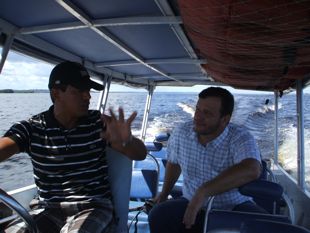
Marco Lima (right) talks with the boat driver as they cross the Amazon River. (Photo: Bobby Bascomb)
GELLERMAN: Marco Lima, a fish biologist, joined our team as interpreter, driver and naturalist, as we set out on our month long journey to explore the Amazon. Today, it’s a short boat ride to see a unique Amazon phenomenon: The Meeting of the Waters.
MARCO: If you look over here we can see the battle of two waters. The Amazon river trying to invade the Rio Negro and the Rio Negro backing off the Amazon waters.
GELLERMAN: It’s a battle of different densities and water temperatures that’s fought out for miles. The black acidic Rio Negro is warmer than the cool, tan Amazon.
The waters eventually merge into the mightiest of rivers. For more than 4,000 miles from the melting glaciers of the Peruvian Andes, the Amazon meanders wide and deep. Vegetation flourishes in the intense, tropical sun making the river basin the richest ecosystem on the planet.

The dark waters of the Rio Negro meets the tan Amazon River. The two travel side-by-side for miles without mixing.
GELLERMAN: There are sharks and pink dolphins, stingrays and electric eels, giant piraracu and tiny but deadly toothpick fish. Three thousand species of fish swim in the Amazon, twice as many as in the Atlantic Ocean.
One-third of the world’s species of plants and animals live in the river basin - wildlife found no place else on earth. Here one bush might contain more species of ants than the entire British Isles.
[BIRDS PEEPING]
MARCOL To understand the biological diversity of the Amazon is extremely easy. Between the big tributaries of the Amazon there is completely isolations. Most of our rivers they have at least five miles wide. And a river with five miles wide is an enormous river. Birds like toucans for example are not allowed to cross because they will fall in before they get to the middle of the river. And you say Marco they can swim. And I tell you no! Because predators are right there ready to eat what ever crosses the river. So many reasons why these areas get naturally isolated.
[SOUND OF AIRPLANE]
GELLERMAN: Even from the air, it’s hard to grasp the vastness of the Amazon. The river basin stretches across nine South American countries. It spans an area the size of the continental United States.
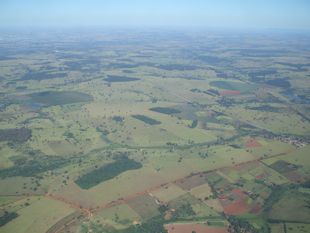
Areal view of the cerrado. The light green patches are soy and cattle fields. Dark green areas are forest reserves. (Photo: Bobby Bascomb)
[AIRPLANE SOUNDS]
GELLERMAN: In a single minute, the Amazon empties enough fresh water into the Atlantic to supply New York City for 60 years. The flow is four times that of the Congo River, ten times that of the Mississippi and 60 times as much as the Nile.
[AIRPLANE SOUNDS]
GELLERMAN: There are few paved roads. Rutted red dirt tracks connect small towns and villages. Isolated indigenous tribes live deep in the forest. Here you’re on your own.
CARTER: You’re very remote. It’s not Kansas, you’re not Dorothy in the Wizard of Oz. It’s very rough region.
GELLERMAN: John Carter pilots his four seater Cessna Skywagon to his ranch in the Brazilian state of Mato Grosso. It means “Dense Wood” in Portuguese.

Swaths of green forest hug the river banks following a national effort to reforest riparian zones. White sand beaches in the river are evidence of the dry season. (Photo: Bobby Bascomb)
GELLERMAN: Fifteen years ago when Carter settled here from Texas that was still an accurate description, but now this is cattle and soy country.
[RANCH SOUNDS]
CARTER: When we first moved here to the west was all forest and we'd sit here in the evening, my wife and I, and there'd be waves and waves of parrots and macaws flying over. Today there's maybe five, ten. There's no more forest left. They tore it all down.
GELLERMAN: Illegal loggers came first, cutting the forests for their valuable hardwoods. Ranchers then torched the remaining trees and brush, converting the land into pasture for cattle. Then farmers came – and planted more profitable soybeans. As he surveys his land, John Carter says the destruction of the forest in this part of the Amazon basin has had a devastating effect on the weather and rainfall.
CARTER: It really is not normal. It used to be it would rain in July and August and cause the trees to flower and it doesn't happen anymore. When I moved here said it’s going to rain next week.

Bruce Gellerman interviews John Carter as the rancher flies his Cessna over the state of Mato Grosso, Brazil. (Photo: Bobby Bascomb)
GELLERMAN: Transpiration: trees suck up water through their roots and release it through their leaves as water vapor. It rises and forms clouds that hover above the forest. When trees are cut down, there’s less transpiration, fewer clouds and less rain.
[PEEPING BIRDS]
GELLERMAN: it’s a cycle of destruction that feeds upon itself. Climate scientists call it: “die-back”. Deforestation leads to drought creating the conditions for vast wildfires, destroying the lungs of the planet.
The Amazon basin, home to so much biological diversity is drying, and dying. And we really don’t know what’s being lost, because the Amazon River basin is not one but many ecosystems, and only a small fraction of what’s living here has been identified.
Biologist Marco Lima:
MARCO: Well, these places are amazing. Why not say that the transition forests are the big Pandora Box of the Amazon.
GELLERMAN: And opening Brazil’s Amazon to development and agriculture in the 1960’s led to unexpected consequences. Today 75 percent of Brazil’s carbon dioxide emissions come from deforestation.
[SOUND OF TRUCK COMING DOWN ROAD]
GELLERMAN: Here along a dusty road near the town of Santo Antonio the dense, virgin forest to the north gives way to savanna. It’s a flat landscape with short trees, scrub brush and shallow ponds.
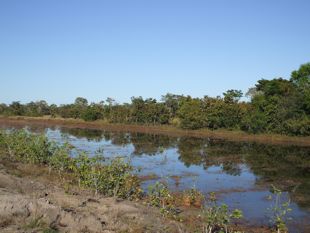
As water holes recede in the dry season animals congregate around ponds like this. That concentration of food makes these areas prime habitat for anacondas. (Photo: Bobby Bascomb)
MARCO: In the cerrado or savannic environments like this we have a higher population of anacondas even more than in the forest. One thing is true for reptiles like anacondas if they see you first they will normally hide very well unless you are really an interesting dish for them.
GELLERMAN: How big can the anaconda get here?
MARCO: Twenty to thirty feet long, that’s easy to be seen.
GELLERMAN: And they’re deadly?
LIMA: An anaconda with 20 feet can kill a man like us. Easy. Control, individually break every single bone we have and swallow us.
[ROOSTER CROWS]
GELLERMAN: But more often - we swallow them. Anacondas, fat and lazy, rarely attack people. But the snake is a popular ingredient in traditional, folk medicines.
[SOUND OF MARKETPLACE, MEDICINE MAN SPEAKING IN PORTUGESE]
LIMA: (translation) This is the fat from the water snake anaconda.
GELLERMAN: At an open air market in the city of Itaituba on the Trabajos River, a vendor sells a variety of potions made from Amazon products, including one with sukuri - Anaconda fat. He says it works wonders for coughs and wounds.
[MEDICINE MAN SPEAKING IN PORTUGUESE]
LIMA: (translation) It’s a great healer after you have some deep cuts.
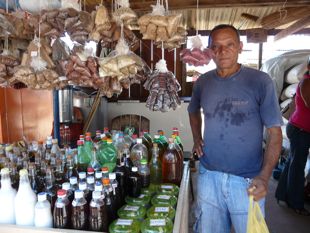
A market vendor stands beside the medicine he makes from forest products such as anaconda fat. (Photo: Bruce Gellerman)
MEDICINE MAN SPEAKING IN PORTUGUESE
LIMA: (translation) Yeah, anaconda fat.
GELLERMAN: How much do I take, what’s the dosage?
[MEDICINE MAN SPEAKING IN PORTUGUESE
LIMA: (translation) 1 teaspoon 2 times a day.
GELLERMAN: I’ll take it.
[MEDICINE MAN SPEAKING IN PORTUGUESE
LIMA: (translation) Take it, it’s good.
GELLERMAN: What do you got for male pattern baldness?
[MEDICINE MAN SPEAKING IN PORTUGESE, LAUGHING]
GELLERMAN: Don’t laugh. It’s estimated that a quarter of Western prescription drugs are derived from ingredients found in tropical forests. But only a small fraction of tropical plants and animals have ever been tested for medicinal purposes.
The biologically rich Amazon could be worth tens of billions of dollars to drug companies, looking for compounds, like Anaconda fat.
But what’s anaconda fat worth? According to Amazon forest scientist Niro Higuchi, it’s difficult to say and expensive to figure out.
HIGUCHI: I have made some estimation to transform this anaconda fat into some product, a drug, you need at least almost a hundred million dollars in data collection.
GELLERMAN: A hundred million dollars to study anaconda fat?
HIGUCHI: Yes, to transform this fat into a drug. So this is something serious. This kind of study demand high technology, well trained people and a lot of money.
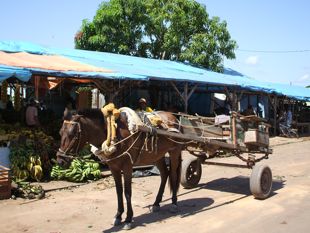
The front of an open air market in Itaituba, Brazil. (Photo: Bobby Bascomb)
The agreement fell through at the last minute. Critics charged the company was trying to rob the nation of its biological wealth.
[SOUND OF WALKING THROUGH THE JUNGLE]
GELLERMAN: Suspicion of bio-piracy runs deep in Brazil - as deep as the Amazon forest itself. The Amazon economy was once based upon the rubber tree. Brazil provided the worlds supply of natural latex. But rubber tree seeds were stolen, exported and Brazil’s market monopoly was lost. Today, it imports rubber.
HIGUCHI: My dream was to come to the Amazon, to study the Amazon Forest.
GELLERMAN: For the past 30 years Niro Higuchi has been conducting field experiments in this patch of the dense forest north of Manaus.
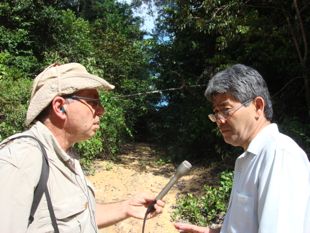
Bruce Gellerman interviews Niro Higuchi about his research to place an economic value on standing forest.
[SOUND OF BIRDS]
HIGUCHI: Oh….now we’re getting into the jungle..
[BIRD CALL]
GELLERMAN: What is that sound?
HIGUCHI: It’s a bird the common name is jungle captain.
GELLERMAN: Jungle captain.
HIGUCHI: He announces we’re here.
GELLERMAN: Ninety-eight percent of this forest – in Amazonas, the largest Brazilian state, is still standing. So far illegal loggers cattle ranchers and soy farmers have stayed out. But Higuchi is worried.
That’s because for all its potential biological value. Right now, a piece of this Amazon forest with trees standing on it has virtually no commercial value.
HIGUCHI: In the Manaus area you can buy one hectare of virgin forest for less than 50 dollars.
GELLERMAN: Fifty bucks.
HIGUCHI: Yes.
GELLERMAN: It’s a bargain.
HIGUCHI: A bargain.
GELLERMAN: That comes to only about 20 dollars an acre for lush standing tropical forest. At that price, the forest is valuable only if its cleared and used for agriculture.
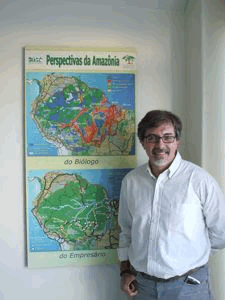
Paulo Moutinho is director of the climate change program at the Amazon Institute for Environmental research. (Photo: Bobby Bascomb)
GELLERMAN: Paulo Mountinho is the Director of the Climate Change Program at IPAM, the Amazon Institute for Environmental Research.
MOUNTINHO: The deforestation rate in the Amazon is so big now because you can not find alternative to use the forest in a sustainable way that have competition enough to face other types of land use like pasture like soy beans like other land use. That’s happened there because people not seeing that it’s possible you have a good life, make money keeping a standing forest.
GELLERMAN: After 3 decades of studying the forest, scientist Niro Higuchi believes he has a solution.
HIGUCHI: I believe in the short-term run if we combine forest management, wood products and carbon business we can keep this forest standing.
GELLERMAN: To be sustainably developed forests must be carefully managed. Higuchi calculates a ton of hardwood per acre can be harvested each year - this would provide income for commercial loggers, increase the forest’s ability to capture and store more carbon, in turn making it more valuable in a potential carbon market. But protecting the forest’s biological diversity? That’s a different matter…

The canopy of the Amazon rainforest as seen from the top of an observation tower. (Photo: Marco Lima)
GELLERMAN: Higuchi’s experiments demonstrate that even largely deforested plots of Amazon will grow back in 30 or 40 years. It may look green and lush but for a thousand years it won’t be the same forest. That’s because, when trees are cut down, the thin, nutrient poor Amazon soil loses its ability to sustain biological diversity.
Paulo Moutinho of IPAM says no one is going to pay to protect soil. What’s needed is an economic incentive beyond biological diversity to save the standing forest.
MOUNTINHO: Usually you are using a cultural argument, a biological diversity argument to save forest but I think that all these arguments are so important but not important enough to save a large area. We are talking about an area equivalent of all Europe.
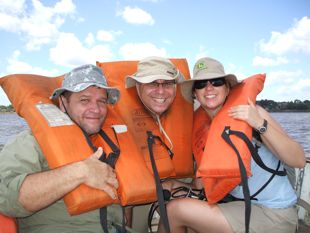
Marco Lima, Bruce Gellerman, and Bobby Bascomb (left to right)
One fifth of our annual worldwide emissions of climate changing CO2 is released when tropical forests are destroyed.
Under the REDD mechanism developing countries with tropical forests would receive payments to keep their trees standing. Industrial nations would foot the bill, paying for their past and future carbon emissions.
Forest scientist Niro Higuchi says REDD can work. It has to.
HIGUCHI: This is our chance to do that.
[SOUND OF WALKING UP STAIR AND WIND]
GELLERMAN: In the dense Amazon forest north of Manaus researchers have built a 150- foot tall metal observatory.
[WALKING UP TOWER]
GELLERMAN: Producer Bobby Bascomb, biologist Marco Lima, and I huff and puff our way to the top, rewarded with a view of the forest canopy that seems to go on forever and a surprise.
BASCOMB: Oh my God, look at that! Wow! A rainbow over the rainforest
[SOUND OF HEAVY BREATHING]
LIMA: Look at this 180 degrees rainbow. Amazing
GELLERMAN: Climate negotiators in Copenhagen will need a rainbow like this: one with pots of gold at both ends.
Guesstimates of the price tag for REDD range from 10 to 50 billion dollars a year. No one really knows how much - or how REDD will actually work. But time is short and the stakes are high.
[SOUND OF BIRDS]
BASCOMB: This is the first time I’ve ever seen both sides of a rainbow.
GELLERMAN: A rainbow is both a biblical symbol of optimism and a divine promise that life on earth will never be destroyed.
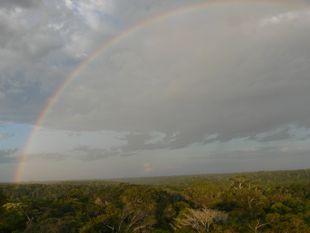
A rainbow shines over the Amazon rainforest. (Photo: Marco Lima)
[SOUND OF BIRDS]
GELLERMAN: But now a man-made disaster threatens the planet and it is we who must find the will and act.
And as the world considers what to do, the Amazon continues to flow relentlessly to the sea.
For Living on Earth, in the Amazon forest. I’m Bruce Gellerman in Brazil.
CURWOOD: Our story about carbon, biological diversity and the Amazon was produced by Living on Earth’s Bruce Gellerman and Bobby Bascomb with help from Marco Lima.
[MUSIC: Severino Januario “Arraia de Santo Antonio” from O Melhor Pe-de-Serra (Movieplay Records]
|
**WEB EXTRA** Reporting on REDD in Brazil - Bruce Gellerman discusses deforestation of the Amazon with host Steve Curwood. (3:00)
Links
|





